Coolcoder360's Devlog/updates thread
-
Alright I actually have some progress to mention now! Decided that instead of trying to keep a weekly cadence, I’d do better by matching my posting with when I have things to post about, and that way I can try to use this to help keep my progress momentum at times instead of as a weekly workitem/todo list task that needs to be completed, it can be instead a “Hey I did xyz and I’m excited about it” kind of thing.
So first: I split the 3D lighting bullet for my 0.0.1 release into multiple parts, I didn’t have any 3d point lighting or anything implemented yet, and was looking into IBL.
So I split the IBL out to 0.0.2, which was the pain part, and I"m working on representing 3d lighting data in the scene via ECS, as well as filtering out that data to the render thread when needed. And Lua bindings for adding that stuff to the scene.That all works, only issue is I think in shaders or something.
Behold what a point light looks like with the same cube I had before:
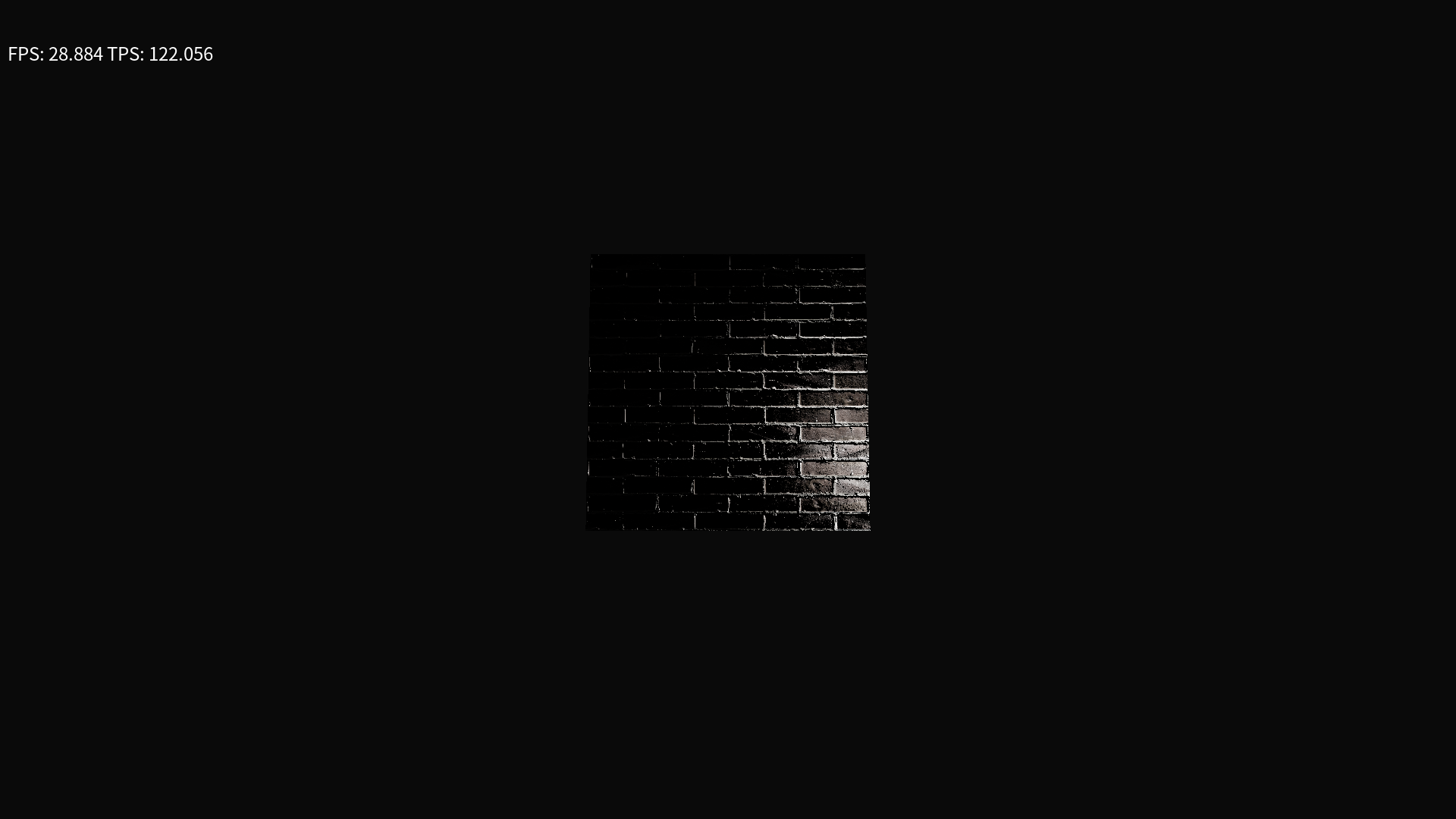
Notice anything strange going on here?
Let’s ignore the FPS: 28.884 part for now
It’s in black and white or something for some reason!Now I tested by having my shader output just “Diffuse” directly, so the diffuse texture is set up properly, so my guess is some issue with metallic, roughness, or normal shaders maybe? Not entirely sure.
I will say this would be a dope shader for a horror game, so I’m not entirely out of business here, but also I’m not convinced that the normal map is the right way round either.
Need to get renderdoc install on my Linux machine from the AUR so I can see the different textures, etc and try to figure out what’s going on. -
Gonna update here again since I fixed it:
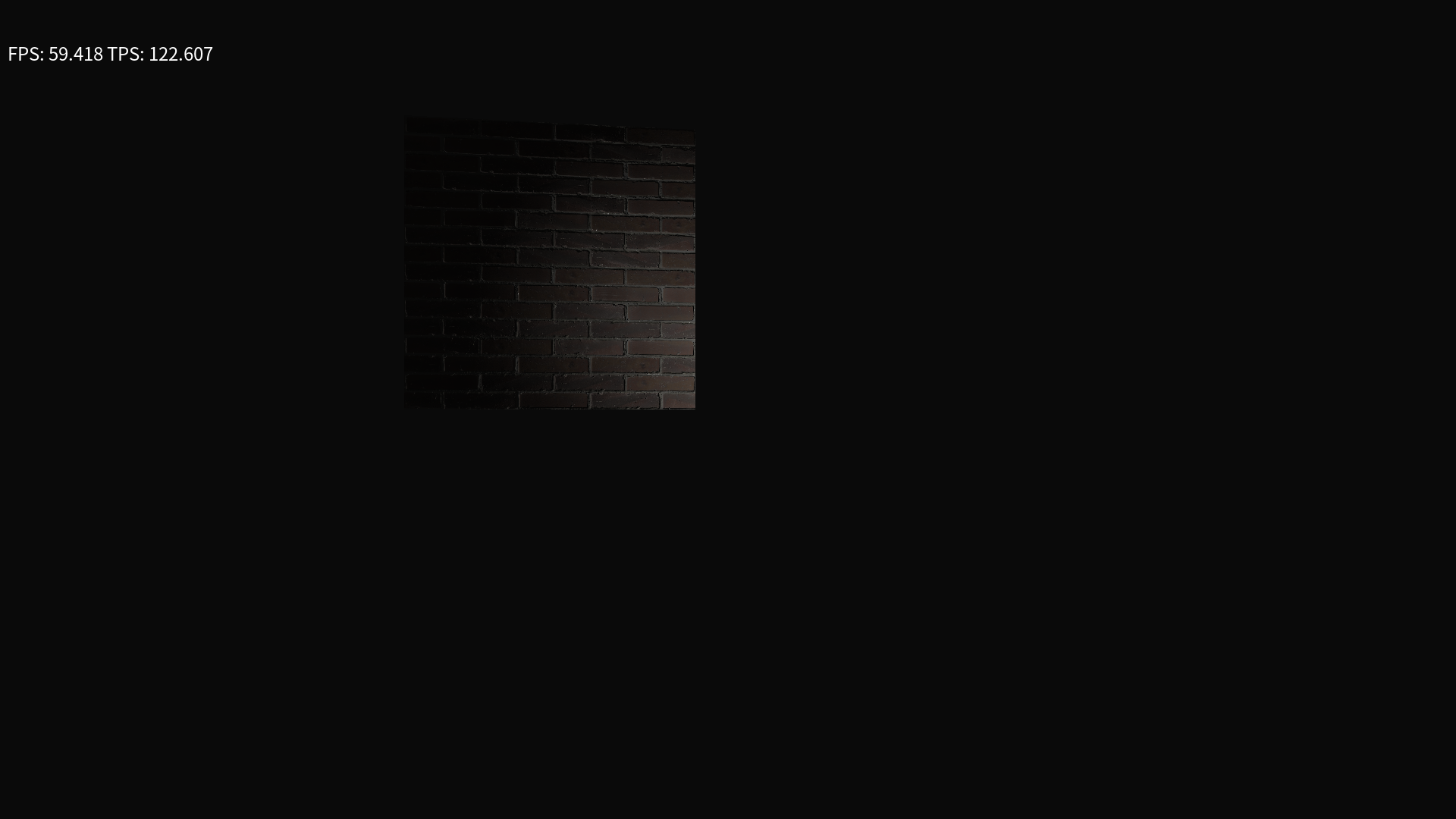
So the answer to the problem was in how I was transferring data between my update and render threads, I had used the shaders before without issue so I wasn’t sure how it was not working.
See I send data between threads via loading up a
RenderStatewith all the data needed to render meshes, etc. Well I added lights to that rather sloppily and forgot to add a line to clear out any lights added to the data, so the number of lights in theRenderStateincreased every frame, and apparently when you get hundreds to thousands of lights added in the same spot, it did that weird thing I was seeing before.Part of what tipped me off is also that after maybe a minute or less the FPS would start dropping to nearly zero, and I figured it had to be something that was increasing or something every frame, and sure enough it was this leak causing the FPS drops as well as the rendering issue.
Problem Solved!
Now I’m thinking I’ll put IBL off to a different release, so I split off that to a different story, as well as spotlights, I’m going to leave “3d lighting” at point lights and wrap this up, so only scene saving/loading and version numbering remain, version numbering is part finished and just needs some Jenkins love and it should be finished. So close to the first milestone I wanted!
-
Some progress on versioning but I don’t think its totally finished yet, still want to take the version number and put it into the filename of the zip file that Jenkins spits out.
But on the saving/loading scenes front I’ve gotten a bit of progress, I chose a json library to use to save things out to json and started writing code.
Not sure yet if I like how the code is shaping up, but right now it makes most sense to me to have separate code paths for each scene saving/loading format, however I’m not sure I like that I have the separate formats in the SceneLoader specific code itself, or if I should have split it off to a separate utility to handle the specifics and I just broke the pieces up into different parts, so I’m sort of split on that since I suspect I"ll need to do the same shit for serializing other things should I need to do that, so we’ll see how that goes.
I chose the Pico Json library for doing the json, it’s a single header file json library, so easy to integrate and the API doesn’t seem to be too much pain to use.
Basically I just use a
picojson::value()to refer to a value, and if I want that value to be a JSON object I just make it be astd::map<std::string, picojson::value>and if I want an array, its astd::vector<picojson::value>. This is nice because then I can just makemaps andvectors as normal and it works, only issue is constantly wrapping everything with thepicojson::valueand I don’t tend to do theusingC++ thing to use namespaces, so I type every littlestd::orpicojson::out, and that seems like it’ll get to be a lot of duplicate typing, since I’m basically looking at having each entity be one JSON object, with keys for each component in my ECS, and then each component is also a JSON object, which keys for its values, which are sometimes also JSON objects.And there’ll be arrays thrown in there in some places too

But yeah so that’s my progress, started on Scene Saving and chose a json library. now the boredom of typing out code to save/load every single component. and then I get to do that shit twice when I add the binary save/load.
Maybe I should get an intern. Or come up with a better way to serialize this stuff.
-
well I guess it’s about a week-ish since my last post, and for consistency I should probably post again.
Not much to talk about on the game engine front, been writing boring json saving/loading code as per usual.
But I started a new project! hopefully it won’t turn out like the last time I mentioned starting a new project in Godot and then stopped working on it pretty much that same week.
I’ve been playing a ton of Tales of the Neon Sea lately, got it free on Epic and boy is that a fun game. It’s got some very beautiful pixel art, and it’s a story based detective/mystery solving game, with all sorts of puzzles and such. it kind of reminds me of a point and click game, but it’s also a side-scroller, and has some really slick pixel art and pixel animations.
I don’t consider myself good at pixel art, I consider myself passable at it. But combine that with being reminded that pixel art in 3d with modern effects looks super cool, and being also passable at 3d modeling, I’m now in the process of throwing pixel art into 3d scenes in Godot and hoping it sticks.
This is one of those projects where I start diving into art first instead of any planning or story, which means its bound to die within a few eons, especially since I’m currently in the process of hand making normal maps for some of my tiles. Very tedious stuff, and I have no way of knowing if it’ll look cool or not.
On the front of making the pixel art go into 3d, I’m not entirely sure on the method I want to use, Godot does support just straight
Sprite3Dobjects, which is basically a 2d sprite rendered in 3d space, and they can be animated like 2d sprites, and have the option to be billboarded. However there’s also this pretty slick addon for Blender I found called Sprytile which is free. Sprytile isn’t like, always the easiest to use or the fastest most intuitive, but it does let you make 3d models with pixel perfect textures, either applying the textures onto a pre-made model, or making models with the textures, and it supports tilesets. so you can basically make a regular old tileset, and then map that into 3d.i’m hoping to combine that with hand drawn normal and roughness maps in Godot, to make some PBR-ish pixel art so I can do some cool 3d lighting and GI effects to hide the fact that my pixel art is bad.
So far I haven’t done much, but here’s a quick peek at what I’ve got with a mostly default Godot scene, and a couple Pixel art assets:
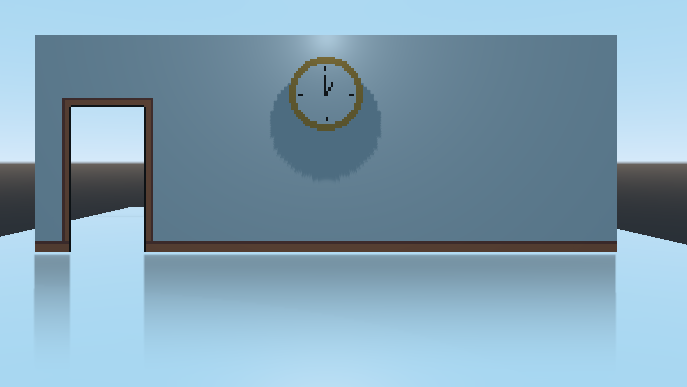
Both the pixel art assets areSprite3Dfor now, and the floor is just aCSGBoxfor now, with a very reflective surface on it to show off the SSR. I’d put some reflection probes in but I’ve found they are kind of shitty for a direct mirror finish like this and work better with more uneven surfaces.I think the plan for if I ever make a character for this is to make a 3d model and render it out as pixel art in Blender, but for now I’ll probably just use a box as the character and try to get some type of gameplay down. I’m hoping that with more of a point and click type interaction it should be simpler to do, maybe some side scrolling segments too, but hopefully I can get some kind of gameplay that consists of interacting with items, and maybe popping up panels to interact with for like, minigame type puzzles.
I think once I get a basic prototype with working gameplay, it’ll be easier to continue from there and come up with art and story once that’s there. That way hopefully instead of having scope creep from making a massive story and then burning myself out on having too many potential coding features, I’ll be able to go the other way, do the coding and add the features/puzzles or the ability to have puzzles and do interactions, and then I can do the story writing and actual game design stuff once I have features that sort of work, I think/hope that workflow will let me not get super burnt out, or at least I can call it quits sooner based on being bored of the mechanics themselves, instead of being bored of making art.
-
Right so I haven’t done much of anything on anything this past week, other than a few small things on the pixel art mystery game prototype.
I added a character who collides and moves the camera with him, and I added a single object that lets you interact with it, and it’ll run a custom script when interacted with.
But I also wanted to mention that I basically joined a game challenge for it: the Crunchless Challenge. Since of course, what’s better to do with your half-baked idea than to join a challenge and impose a deadline on yourself?
The idea of the challenge is that it’s not a competition with voting, ranking, or anything like that, its more of a personal challenge to plan out all the other things than just chunking out the game, so by the end of it, I should have a whole game made, polished, marketed, and up for sale on a store page, without any crunching.
Posting Devlogs counts as marketing as far as the game challenge is concerned, so maybe I’ll be a regular at gruedorfing for the next few months!
Also since its not a competition, there’s no hard start date, you can resurrect old projects, use code/assets/pieces you’ve made before, etc. it’s more of like a prompt to kind of get yourself going.
I think the main difficulty here of course is going to be similar to all game jams, limiting your scope. I basically have a whole list of features I want in this game idea, and I’m going to have to cut it down to a reasonable number, and then like, write the story. Deadline is the end of November to have it all completed, polished, marketed, and up for sale.
I think my current plan is to just have a small subset of the features/mechanics I want in for that, and then just release a single part or chapter of the longer story in November, that way I can fulfill the challenge, get a demo/story hook out, and then maybe get some testing time on the mechanics I do have before I add more.
In terms of pricing I’m thinking a pay what you want model for the first chapter, or completely free. the idea being that it hooks you in to want to buy the rest of it.
Of course I’d also need to write a hook or cliff hanger or overall story plot thing, and I need to find a setting, I’m split between just sci-fi or trying to do some sort of period/historical setting, since that also sounds fun. My guess is I’ll need to decide that before the challenge technically starts, which is at the beginning of November.
-
Yeah I decided not to do the mystery/detective/story based game for the crunchless challenge, because I’m not fast enough at writing to be able to write a story between now and november to implement.
So instead I decided to go with a dungeon crawler roguelike idea, basically inspired by Nethack and Ultima Underworld.
I figure if I can get world gen working then I can just make a crap ton of tiles and basic combat and boom there I go.Also decided to use Raylib for this project, which I’d never used before, and I accidentally slipped yesterday and basically got a whole main menu, character creation screens all done, and some basic character stat generation working, although I haven’t figured out how to have the RPG combat work yet so I might need to rehash that at some point.
Working on doing the map gen now, basically I plan for it to be done using Wang tiles, I would do herringbone wang tiles but having never done wang tiles before I think it’s better to start off with basic square tiles and go from there.
Here have some screenshots of what I got together after work yesterday:
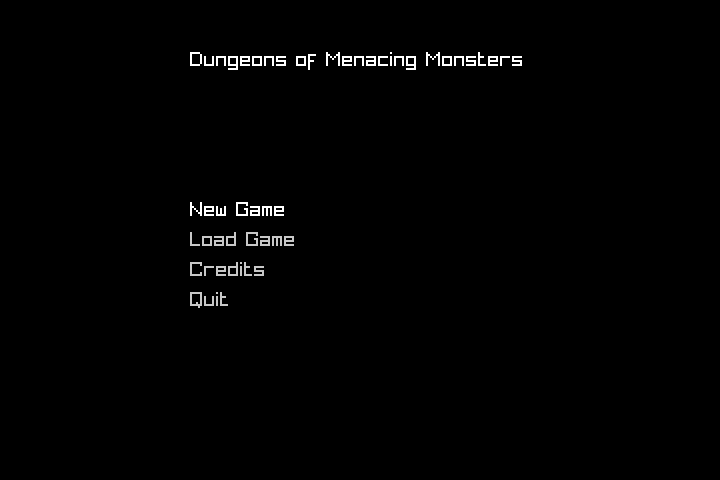
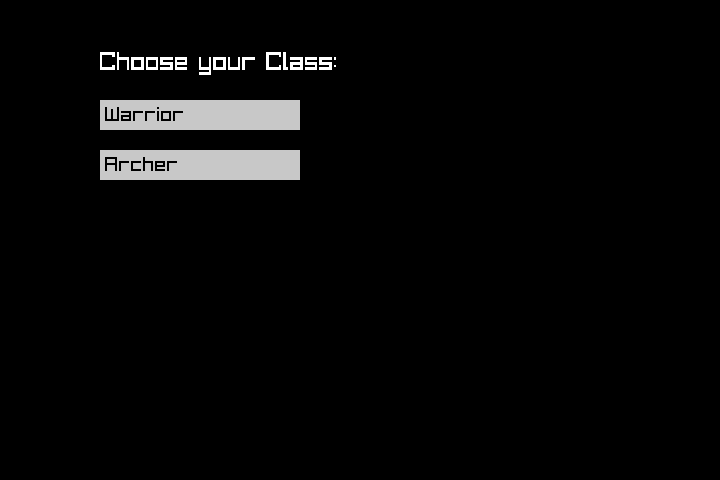
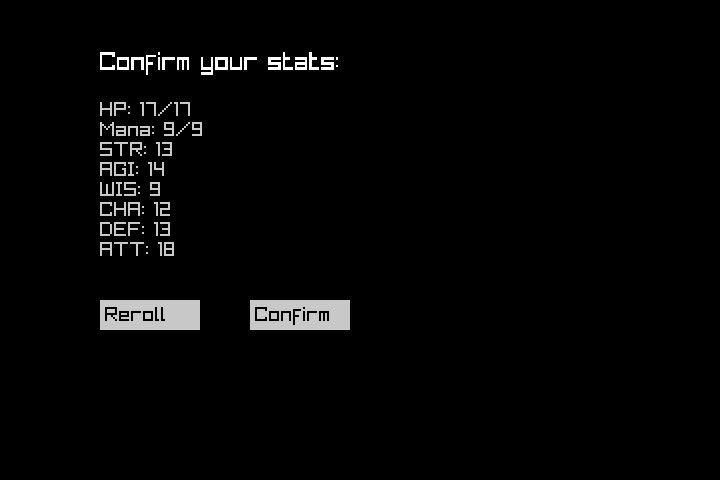
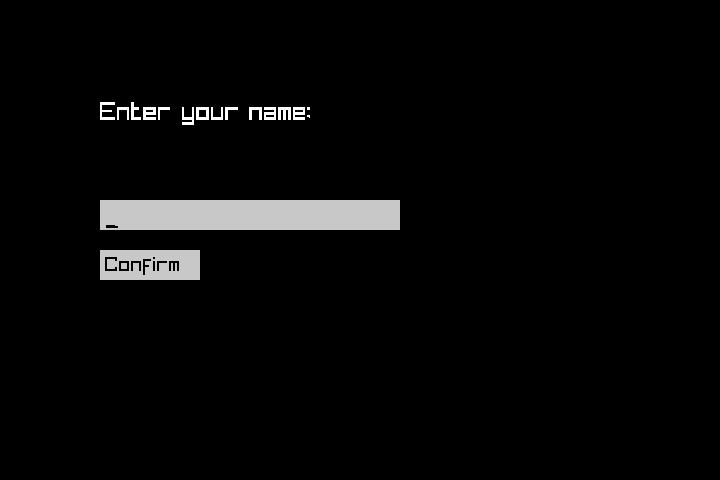
Maybe the only thing I need to update/change, is that the main menu uses keyboard input only to select the options, and everything else is mouse only, so I need to figure out how to allow both keyboard + mouse for everything, but tbh maybe going mouse for most things makes more sense.
-
I managed to get a type of procedural generation implemented using wang tiles, I’m using square wang tiles and representing everything in a grid based system, which lets me easily input tile data manually by filling out integer arrays. So I pre-fill a bunch of tiles, and then I have a separate array which holds the connectivity data for each tile, saying what sides are meant to connect to other tiles and where.
Using that data, I can generate reasonably okay looking maps, here’s a 5x5 wang map:
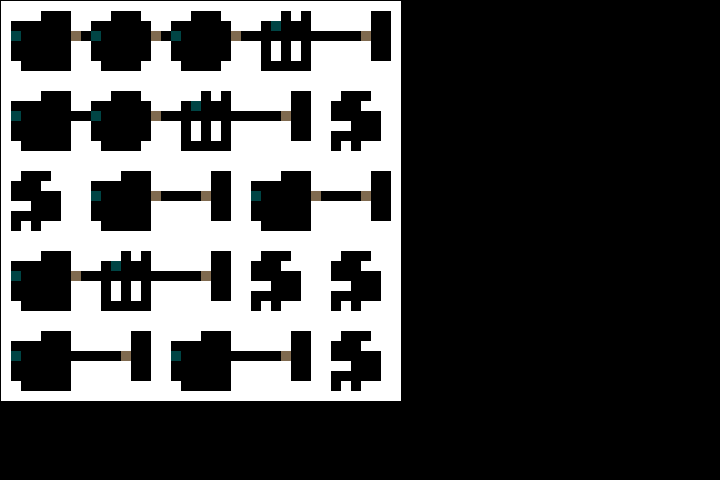
Basically I have it consider the edges of the map having blocked connectivity, then have it randomly select tiles from the set of pre-made tiles that will fit in that location. This is great for randomly generating a disjointed/disconnected map, and then I can also add some tile data for enemy, NPC, Item, door placement. In the picture above you can see brown squares where the doors would be, and a little blue square for where a potential stairway could be placed.
I haven’t figured out how to actually place the player spawn or stairway down yet, I hope for it to be like nethack, where you basically “spawn” at a stairway that goes up to the previous floor, and then you try to find the stairway going down to get to the next level, so ideally I’ll need a way to make sure that the spawn/upstair is connected to the downstair, so that it’s possible to actually make your way to the end of a level.
While I could implement some kind of wondrous pathfinding algorithm to do this, I don’t think that’s the best solution, definitely not the fastest and most bug free. I think instead since I already have it choose tiles based on the connectivity of the tiles that are already placed around it, maybe I could pre-define different connectivity maps for levels, so it could randomly choose a connectivity, and then it would know that any tiles that are defined in the predefined connectivity map as being connected are free real estate for being a possible stairway down or up.
The minor issue with this of course is having to make sure that all the tiles are also internally connected within themselves, which does limit the ability to have potentially interesting tiles, but I’m also thinking of potentially letting players just kind of, bash down the walls of the dungeon anyways, maybe with a pickaxe or a shovel or something. That seems like a solid way to help provide a way out in case the player gets stuck, and/or the map gen is half broken. Only issue is figuring out how to tell the player where to go, as well as how to keep them from escaping the map.
Okay and there’s also the issue of having to manually make multiple connectivity maps of multiple sizes, since I plan to be able to hopefully scale the floors to be bigger and bigger the farther down you get. Costs me no extra effort on my side to generate massive floors as long as it’s purely random generation with no manual connectivity maps.
Maybe instead of manually creating connectivity maps I just did a random walk for a bit instead? that would ensure some things are connected, would let me place tiles, and would mean less effort than manually creating the connectivity as well as allow for massive levels at no extra manual effort, and allow for more variety in map layouts than just the same 3-5 connectivities I would make manually. Plus it could totally wrap around on itself and have intersections if needed, but I’ve never done a random walk before and idk how well that would work to create a workable map, or how many steps it would need to have for different sized maps.
So that’s all sort of figured out, here’s what’s next:
- Figuring out classes
- Finalizing player stat generation for classes and generating starter inventories
- item using/management
- UI
- representing the 3d world
- combat
- I’ve never designed a turn based rpg and been satisfied with how the numbers are all used for combat, I’ve thought of looking into how GURPS and DnD do it, and then ripping them off, but I think that’s likely to run into licensing issues, and I worry it’ll be too similar to other GURPS or DnD based games. If you have any experience designing turn based RPGs and figuring out how to make numbers mean things, hit me up with ideas!
- coming up with some kind of macguffin goal to the whole thing
- seems like players won’t want to endlessly trudge through a dungeon, maybe having some purpose to go down there for, and then having to get back out or come back a different way would help add depth or something, but any likelihood of having a return trip would probably be stretch unless I can find a way to make the return trip fun again.
- finishing up map gen to generate enemies and items, entry and exit points
And some stretch goals:
- Shops
- I’m thinking similar to nethack possibly where items are laid out on the ground, you can pick them up and examine them, and then a shopkeeper stops you if you try to leave without paying, but items can be snuck out via teleportation or other ways, or the shopkeeper can just be disposed of.
- maybe some more story or something.
- pets maybe?
- in Nethack you start off with a pet, which is very useful because they will sometimes pick up items and drop them on their own, combine that with what I said above about shops in nethack, and yeah very useful to try to keep your pet alive if you can. Definitely try not to accidentally kill your pet, I’ve done that before.
- Deities?
- at this point it’s probably ripping off nethack too much and I may as well just crib nethack’s code and add 3d rendering on top of it, but hey it’s a classic for a reason.
Tune in next time for hopefully some kind of UI and/or seeing the world in 3D!
-
And consider the random walk method of improving connectivity and ensuring more of the map is connected to the rest working!
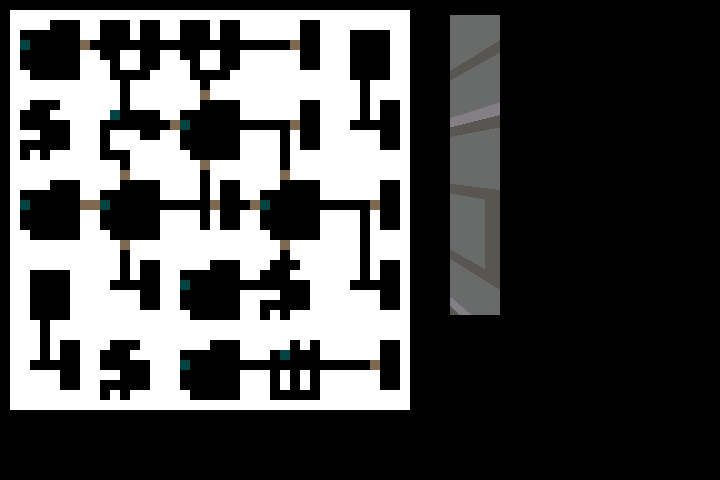
Much better connectivity and much better variety in terms of which direction the halls cross each other.
One caveat to this is that if no tile is found, then the default tile with no connections is used, that might be a problem since that can block off paths that may be wanted. Not sure if I want to make the default wang tile be completely connected or not, but that would prevent any blockages for sure, so then at least if spawn and stairway down are both on the random walk, then they will be connected.I also have 3d rendering working for floors/walls, but not really any of the other tile types.
Issue is that I haven’t done the player spawning yet, so you just spawn in the wall at 0,0, and can’t move out of there. -
Bout time for another update I think.
So I got the 3d movement and spawn/exit location picking working ish just after the last post, so now you can see what it’ll look like in game:
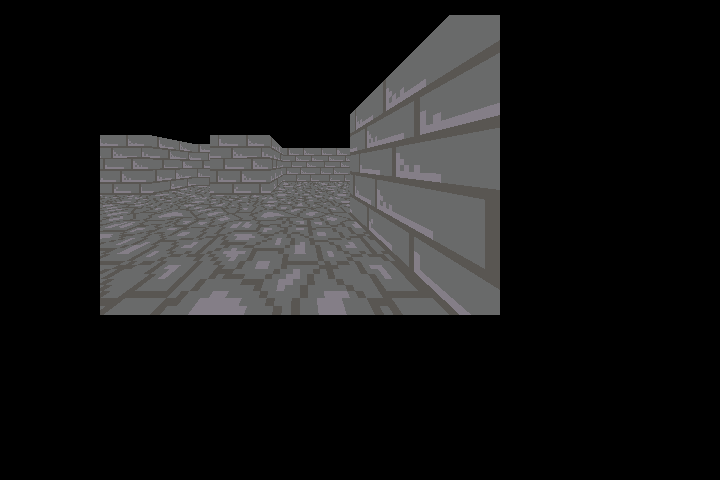
Yes movement works.
Then I also made the map look much better too with map zoom and scrolling buttons:
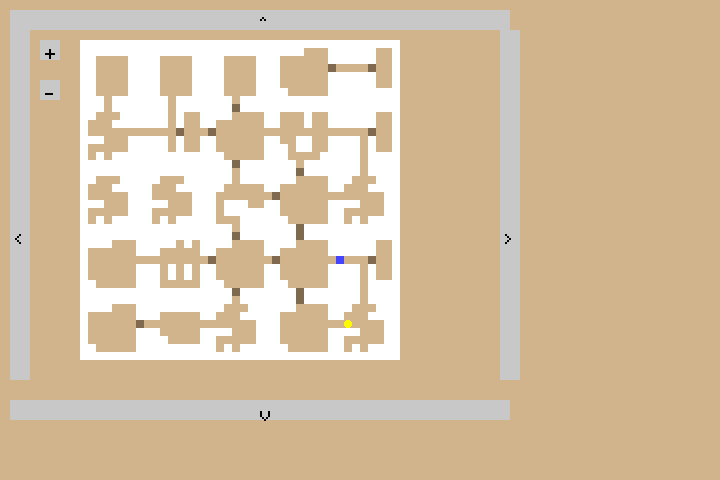
The reason I say the entry/exit location picking works-ish is because I’m not really satisfied with the location selection, basically right now it just chooses the tile, then loops through the tile to select the nearest “open” square, it does this because I didn’t bother to have it track which tiles have the spawn/exit values in them, so right now it’ll end up putting the player and the exit into the middle of a hallway.
You can see the player as the yellow circle on the above map, and the exit as the blue square.
I’ve thought about potentially having the map track/only update if you’ve seen an area, but that seems like potentially scope creep I don’t know that I care for, so I’ll probably look into that after I get enemies and combat working, since that’s like the next things required to make this actually be a game.
I think next time I’ll try to have more UI figured out, not sure I’ll do inventory, but at least the scrolling text showing what happened, or what is going on would be nice to have so I can potentially have debug printing in there instead of to console.
I may also see if I can set up a jenkins job to build this as well, since I already have a jenkins semi-working on my laptop, it has bad uptime, but if it works to build Linux, no problems there, then I might take a break from dev on this project to work on making a docker image to build windows builds from linux, which would be helpful so I can just press buttons to get both builds of this project. Since I plan on chunking this project out commercially prior to finishing up my game engine project.
-
Right so the start of this crunchless challenge that I’m working on this roguelike gridder game for is looming ever nearer, and so now the pressure of actually trying to plan/figure out if I can finish dev, market, release for sale the game by the end of November is starting to increase.
Based on the scope of what I want to include, including all of it in the initial release at the end of November doesn’t seem feasible. Also the price I found to be ideal for this type of game based on the bit of research I did for other similar games seems too high for what I think will be possible at the end of November, so I think my plan is to release in Early Access at a lower price, then release updates for a bit, bump it out of Early Access and increase the price to the price I found through market research.
So I spent a bunch of time putting some items into Quire, trying to organize based on need/want, tagging with type of task, and started organizing the initial release.
I feel like I’ve gotten a lot of stuff done with the level generation, etc, but wow is there a lot of stuff left. 22 tasks in for the end of november so far, and potentially more as more items are thought of. Luckily some of those I think can be cut from the release if needed, although all of the items are things that I think would be nice to have in a paid early access.I’m also adding in a bunch of other items to try to plan out one or two other releases after the initial release, I think if I want to ever kick this entirely out the door and get back to my game engine project I’ll need to wrap this darn thing up within a few months so I can re-focus on my engine, if anything cutting most of it and selling for less than the market research price i found seems like a reasonable action instead of leading people along to have a ton of planned features.
Of course releasing something for sale as early access implies that there will be possibly significant features to be added in the future and ongoing development, so I’ll probably want to define what is going to be added prior to release in order for transparency to any possible purchasers of the game. If anything I’ll probably go for the under promise and over deliver policy just so that people feel like they’re not being cheated out of something cool, and instead will get new things added in as they are available.
Due to that policy of under promise and over deliver, I suspect not making a statement on how much the final price will be is a good idea, that way it can be adjusted based on how much content is actually chunked out. In addition, cutting the early access price to be low seems good to ensure that even if nothing else comes out after the initial release, that the cost will be worth it.
I suspect adding new content as long as it isn’t new mechanics should be fairly straight forward, so I think there is definitely going to be at least 1-2 more releases after the initial release just to output more content to be distributed into the procedurally generated levels.
So on to describing the tasks and how I organize them.
First I’ll give the disclaimer that of course none of this is committed to be in the final product yet or to ever be released this is just a working wishlist of items that would be nice to add.This is all of what I have planned to do between now and November 31st so far, with possibly more stuff to come (Note that testing or polishing isn’t really included here, this is basically getting a MVP out the door and for sale as Early Access):
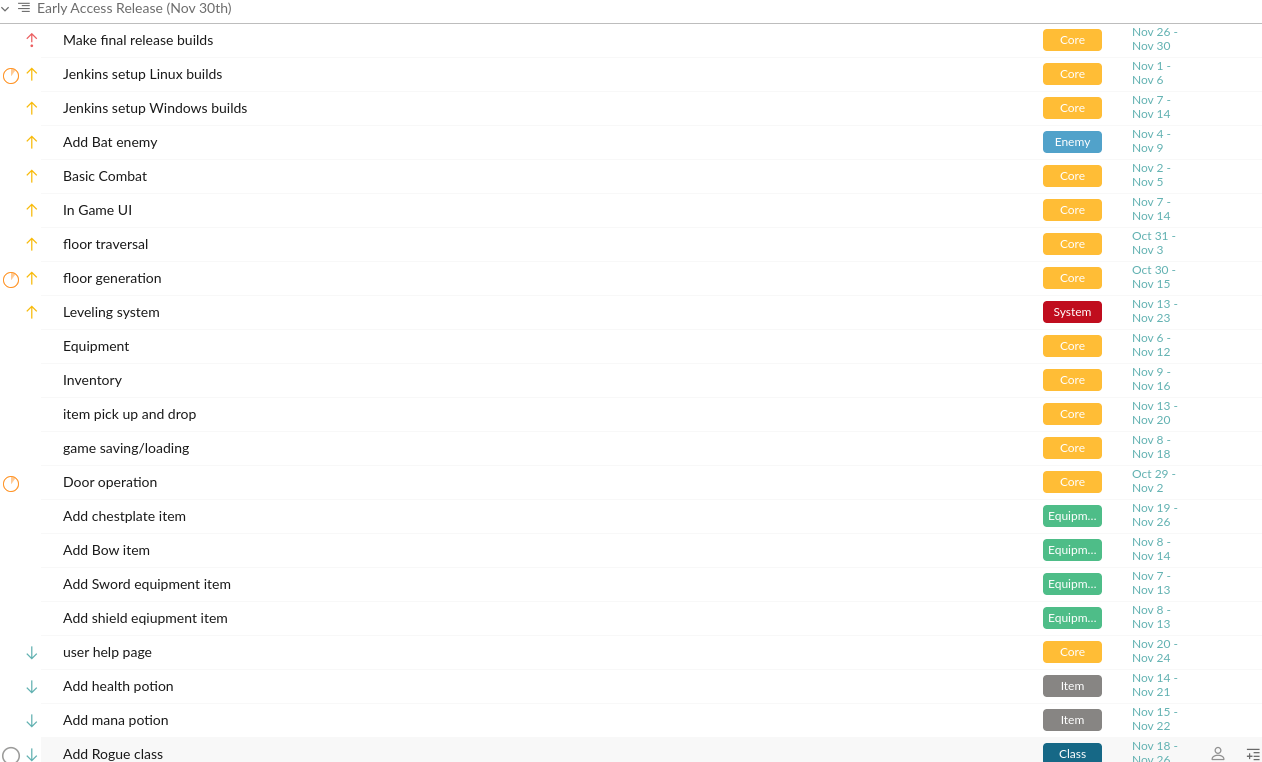
Basically I’m organizing everything with tags to say what kind of item it is, if its got the “Core” tag it’s considered fairly crucial to the initial release and cannot or should not be cut.
From there I lumped it into a sublist of just things I want to do for the initial release, and then gave everything start/end dates to try to ballpark how long each item will take, etc. One issue though is I’m not properly pointing/estimating time, because there’s always going to be some variance in terms of how long things take or how often I feel like working on this project.
I also have a sublist for a proposed follow up feature release after the initial release but of course, that’s all mostly up in the air based on how long this takes and how long those features take.
Probably the item that will cause me to fail this challenge is of course, not feeling like working on it and playing on the Switch instead. I consider all of the programming work completely doable in this time frame with the caveat that it might be considered crunch to fix all the bugs, and the art is going to be rushed pixel art, so it’s not going to be anything fancy or take too much time.
-
The Challenge has started!!
I’m also devlogging this stuff over here on itch now too. Mostly so that I can hide the rest of my ramblings and meanderings and failed/forgotten projects away here

I’ll still probably update here on occasion but not necessarily once a week if I’m busy updating over there and then worrying about how I’ll get all this stuff done.
The Good news: I cranked out the door stuff and the floor changing stuff and a little scrolling text box yesterday! That knocks out like 2-3 items from that list from last update here. Also did a bit of prep for enemy generation on the levels, so that’s good but not there yet.
The Bad news: I forgot that the challenge also includes like, marketing and branding and crap and forgot to add those into my quire task list yet. So I need to figure out things like trailers, flashy screenshots, writing some sort of blurb and stuff on the itch page, etc. Or at least throw those tasks into my todo list and plan time for them.
Might also need to start tweeting again to like, promote this darn thing if I want to actually sell any of it near the end, but of course it doesn’t look pretty at all yet, and I don’t think it ever will, so maybe I need to not do that yet… Hard to say how to market something that looks like programmer art and will always look like programmer art.
Here’s what it looks like now with a door, and some test text and some real text in the text log box thingy:
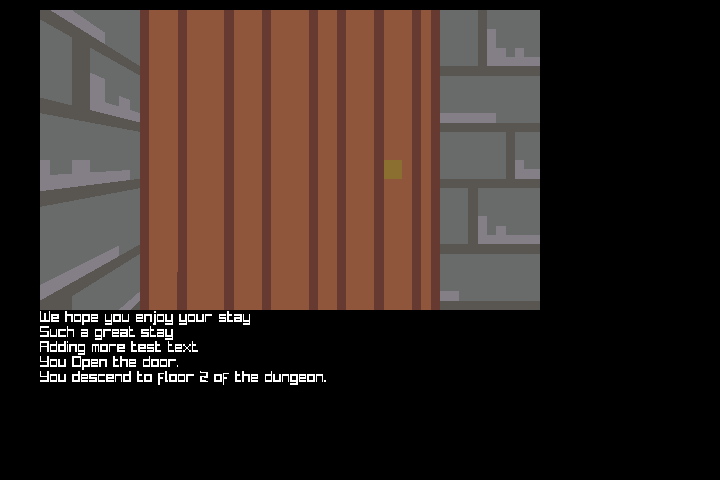
Next up is enemies + combat, as well as getting the Jenkins Linux build going.
And jenkins Windows build is planned as well, since I suspect I won’t get many sales without a Windows build
Also plan to have a compass for telling you which direction you’re facing, which will work better for using the map and knowing which way you’re facing instead of having to move around while on the map screen. (Which is totally possible and I’m not planning on removing as a feature, easier to let you move with the map up than to bother not letting you move with the map up) -
Challenge started 2 days ago, and I already got distracted with a different project which looks more exciting…
So my Invicta 8932 watch which I like, just got back in March decided to stop working, and now is only working sporadically. It’s still under warranty, but apparently is discontinued, so we’re not sure if we’re getting a replacement or refund, so I started looking into smartwatches.
I don’t want to drop like $300 on a smartwatch that I can’t tinker with, so I was looking into hackable/programmable smartwatches. I found Watchy which looks promising, $50 for basically an assembled PCB, an epaper display, and a strap, but its out of stock. There’s also the Bangle.js but it’s $100, looks nicer and is waterproof (and in stock), but that’s a lot for something that runs someone else’s firmware, and I have to program in Javascript of all things.
So what’s the alternative? Why I’ll just make one, I have a degree in Computer Engineering that I use to do Software engineering, it’s about time I dove back into hardware and PCB design. Watchy is made with the ESP32, that’s a chip that supports Wifi, Bluetooth, and Bluetooth Low Energy (BLE), and I know it comes in a module that has all the RF work done for me, and is already FCC certified.
But of course all the ESP32 modules I can find are entirely out of stock… but the 48-QFN is in stock!
Except that I’m not going to be an idiot and try soldering a 48-QFN this time, last time I tried doing a 28-QFN and I couldn’t tell if I got it or not.
To give an idea of what I’m talking about, here’s the 28 pin QFN package I have that I tried soldering once upon a time. Notice that it is placed on a dime for scale, not a quarter:

I put it upside down so you can see the contacts, those go down onto the PCB, and are not visible from the outside, you have to hot air flow the solder while blind and hope you get it right. Usually these types of joints will be done in a reflow oven (which I don’t have) and verified using Xray to check connections (Which I also don’t have).
Yeah so no way I’m doing a 48 pin QFN any time soon, at least QFPs have the contacts as little legs that stick out so you can inspect them with a microscope (Which I also don’t have, yet.)Plus if I go with the 48-QFN then I have to do the RF board design, design an antenna, hope it works, and spend money on PCB fab right away without even knowing if it’ll work, so that’s not what I’m going to do for this project (this time… I have a bad habit of jumping into PCB design without having prototyped anything, PCB layout is very fun and one of my favorite things in college so I like to go do it if I can.)
Instead I’m looking at dev boards, because sure the ESP32 modules are all out of stock if you want just the module, but I found these ESP32 dev boards on Adafruit which look like just the right thing for testing this stuff out.
They include the ESP32 module I would hope to find back in stock eventually, and all the necessary supporting electronics on it, with a handy micro USB port to program it through, and likely it already has a firmware that allows in circuit programming, also a built in LiPo/Li-Ion charger circuit, and USB to serial (serial usually means UART, that’s how you get a console out of a microcontroller, and how you get bootloader logs out of a SoC. (ie how you debug a phone that doesn’t boot))
So we’re going with an ESP32 module with this datasheet. Reading datasheets is a bit of a skill in itself, and it’s less stressful if I’m using a dev board, because I don’t have to try to decode what circuitry is needed to make the thing go, that’s already done, I just need to look at things like features, pinout, and then also figure out the pinout of the dev board, and from there I can choose what sorts of sensors, gadgets, doohickeys, and devices I can hook up to the thing.
First section you want to check is the overview section, usually there’s a short list of all the fancy features your microcontroller or other component has.
The big hitter features on the ESP32 are the Wifi and Bluetooth features of course, but its also got a 32-bit dual-core on it, clocking at 240MHz, which isn’t a super high speed processor, but I think it should do for a smartwatch.
And like standard microcontrollers, you can do UART, SPI, I2C, PWM, and some other more exotic features. Capactive touch is a cool one on the ESP32, as well as IR. So that’s some cool stuff.The datasheet is all about the hardware itself usually, it will have things like the pinout, electrical characteristics, temperature behavior, the shape and size of the part, safe operating temperatures, voltages, and currents. That sort of thing. But it doesn’t tell you how to actually do anything with it, for that you have to find a different document, which is luckily linked in the ESP32 datasheet, The technical reference manual Sometimes what you’re looking for will also be called a programming guide, user guide, or something else to that effect. There is also a separate User Guide linked to from the datasheet, but we’ll check the tehcnical reference first.
Typically when you’re going after programming a microcontroller you want to try to find what’s called the Register Map or the Address Map. Basically you access all the peripherals through memory addresses, so the way you figure out which part of memory to access for what is to look for the Map that tells you which part is for which things, or sometimes you just go to the section for what you’re looking on how to do and it’ll describe it there.
For example, if I want to figure out how to use the SPI interface, a 4 wire method of talking to other things, just go to the SPI section, and you get a whole bunch of details on timing, interrupts, etc, and then there’s also a handy Register Summary here, which details all the addresses of the registers needed to do SPI stuff, and what the registers do.
This is great, but also note that you may not need to do this in depth reading of the manuals, most of these boards also come with libraries and such for common development environments, so it may not be necessary depending on what board you choose and what you’re doing.
So I’ve got the microcontroller selected, and I can find the features that are available on it very easily, next up is figuring out what to put together with that to make a watch!
So there are a few things needed, like a display and some form of input, but also some other items that would be totally cool, specifically in the sensors category:
- A screen or display, need to choose touchscreen, non-touchscreen, OLED vs Epaper vs TFT vs LCD
- Input/controls
- Buttons
- knobs?
- Sensors/other peripherals
- Motion sensor, typically used for tracking steps, not sure I care about that.
- air quality sensor, CO/CH4 sensor - Feels like a cool feature to have on your watch, being able to detect dangerous gases and such
- temperature, humidity, air pressure sensor - not necessarily the most useful since you can already feel two of these things at least.
- geiger counter/radiation sensor - extra cool factor
- IR blaster - need to replace the one on my dying phone with something else I can have always on me to control the TV volume, I lose remotes too easy or I’m too lazy to cross the room for the remote.
- microSDcard reader? - Not sure on this one yet, seems like it would add cost but not sure there’s much point, depends on how much storage is needed and what all the thing will be doing, and even then I’m not sure if removeable storage makes sense vs just EMMC or something like that.
- LEDs - Not really necessary, although having a bright LED for use as a flashlight could be handy, probably a battery killer though
- Battery
- there are a ton of different kinds of battery chemistry all with pros and cons, so likely I’ll need to research NiCd, NiMh, LiPo, Li-Ion, varieties. Adafruit has a LiPo that is made to go with the dev board I’m getting, so for now I’m just going with that, the 500mAh kind, the dev board already has LiPo/Li-Ion charging and monitoring circuitry and connector. All I do know for now, is I’m going with rechargeable in the final design, and probably need to make sure its not an explode-y kind, granted having a self destruct feature on your wrist does sound cool, it’s not really the kind of thing my wife would prefer I think.
So that’s hardware, but what about software?
So I haven’t done anything with an ESP32 before, so I’m not fully certain on the dual-core nature of it, and how to best program for that, so I’m likely going to be using a pre-built software package, either from some example ESP32 code, or potentially an RTOS (Real Time Operating System).RTOSes are usually used on microcontrollers for safety, mission critical systems, they are preferred for systems like that over a scheduled operating system because RTOSes are deterministic, they will schedule threads in the same priority order over other threads, so while there is the mess of setting the thread priorities, once set you’ll always know that your mission critical threads will take priority over the non-mission critical threads. At my old company the people doing the RTOS dev were separate from the Android and OS/BSP guys, I was one of the Android and OS/BSP guys so I’m not familiar with RTOS development, so this will likely be a fun experiment.
There is likely the question of “Why not run Linux?” as well, I am more familiar with Embedded Linux, especially in the Android ecosystem, than I am with RTOSes, but there is a slight issue here, the dual-core only clocks at 240MHz, I’m not wanting to use up any more of it with a larger OS than is needed, and in addition, the amount of RAM available is measured in KB, I think even the lightest Linux builds want at least a few MB of RAM, in this case we get only 4MB of flash memory, which is the not RAM storage kind, but the “program lives here” kind, so not only would Linux need to have enough RAM, it would need enough storage, which would mean writing just a bootloader and then having that load the Linux kernel from elsewhere, and good luck getting your kernel to fit into KB of memory.
So that’s it for this long-ass adventure into hardware and making a replacement watch. Hopefully I won’t stay distracted from my roguelike for long, and I can get an order in with the dev board so I can start playing around.
If anyone has any ideas on how to find a good 1.5" to 2.5" display, let me know. I’m likely to get a display module I guess but they run like $20 for a 1.5 inch display, and come with an sdcard and other crap. I’m starting to look into AliExpress but that’ll take like a month to ship to me if not longer, granted it looks like you can get what I need for like $6
Next time I hope to be back on the roguelike, and/or have some sort of hardware to show off!
-
Well here we are, the end of November. I 1000% got distracted by other things instead of working on the roguelike for the crunchless challenge thing I was trying to do. But hey I didn’t crunch on anything so i succeeded on the crunchless part of it! I just didn’t do much of anything programming or game dev related.
My 3d printer came in and I got distracted and now have another new project: I’m making a redox split keyboard with Kailh box jade switches. Parts are all on order and arrive in January, printing the case and the keycaps myself, so far the two test keycaps I made feel okay to me, but I don’t have any other box switches to test fit them with so I need to wait until january when they arrive to test fit them to make sure that they will work.
Back to the Game engine project
Yeah I went back to working on my game engine project again. Still trying to get scene saving/loading working, still using json for that, and currently bored of writing save/load logic so will likely keep saving json until either I run into it taking up too much memory/space, or it takes too long to load when needed. I think lazy route is best for getting anything actually finished/shipped.
So basically I’m stuck on writing out how to convert a bunch of different components that an entity might have to JSON, and then I eventually need to write the code to load all that back in too, which I don’t think is even started yet.
But it has been a while since I provided screenshots, and I was super close to getting json output actually, so here have some screenshots of me showing me typing a console command to save an entity, and then let me show some json that was generated from the Entity that was saved.
Screenshot first:
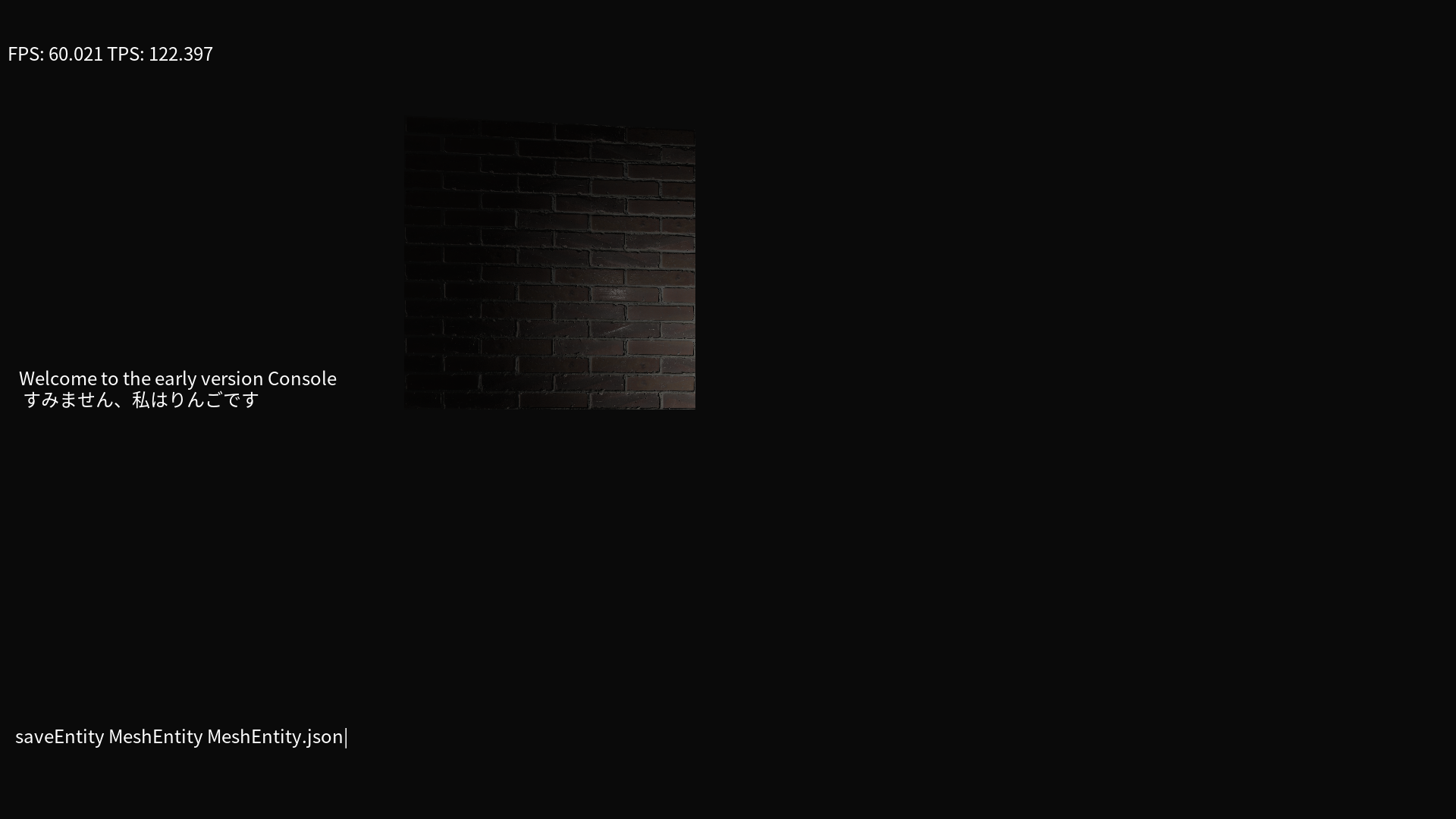
And a screenshot showing the feedback you get from running the command, I know it’s not much feedback but its something:
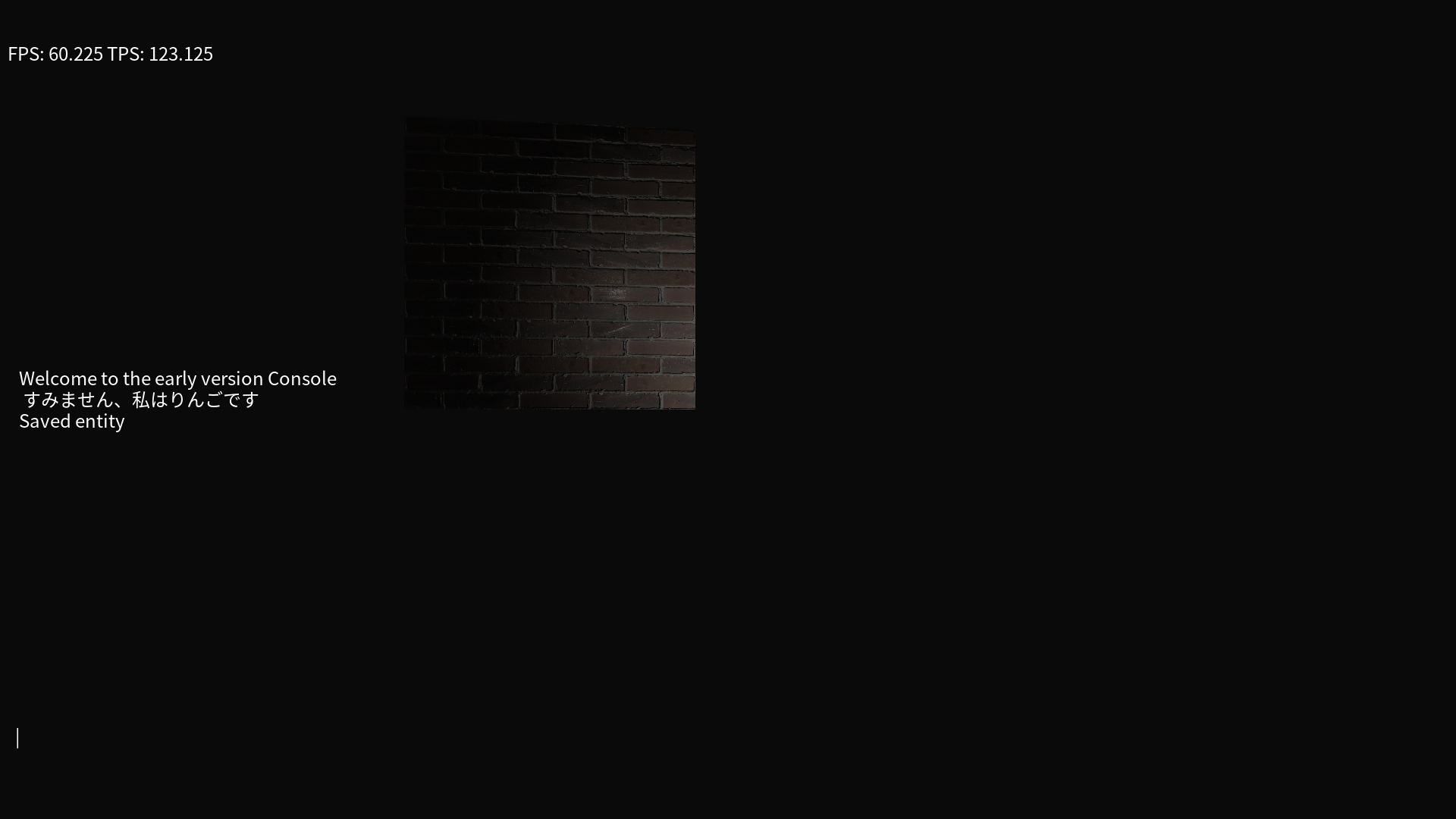
And now check out the json generated for the cube you see in the screenshot, in a file called “MeshEntity.json”
{"EcsName":{"value":"MeshEntity"},"TransformComponent":{"position":{"x":0,"y ":0,"z":0},"rotation":{"w":0,"x":0,"y":0,"z":0},"scale":1},"VisibleComponent ":{"opaque":true,"visible":true}}I haven’t fully figured out how I want to save Mesh components yet, part of the issue is with this specific case, I don’t have a RUID/path to just store to a model, that mesh is generated in Lua, which means that if I wanted to store it I would likely have to parse/store out the entire freaking mesh into the json, including vert data, face data, texcoord data, and maybe vert color data, and texture data somehow since the texture is handled by being a material set to the mesh.
So I’m so close yet so far. I’m hoping that if I set up model loading from files, that I can make it easier to save that out to json, and then either just won’t save programmically generated meshes, or something. idk yet.
I also have a few other components not implemented yet, and loading hasn’t been touched at all, neither is saving the children of the entity selected to save. But still this is good progress!
-
Guess I’m not good at doing these posts weekly anymore so I’ll jump in here again even though I’m not where I wish I was.
I have entity saving working for saving out the children of entities now! fixed some bugs with getting the list of children from the Lua code!
Working on getting the loading done now, and it’s as boring/painful a slog as saving was but worse somehow. (I didn’t write any helpers, I’m writing crap out longform like
picojson::valueandstd::map<std::string,picojson::value>and thenvalue.get<std::map<std::string,picojson::value>>()kind of things.
For each time I need to get an object out. and then more crap for getting values from the object.Needless to say I’m not super highly confident/happy with it but hey it’ll work once I slog it all out… Just adding saving/loading new components will be some major pain I think.
I was just going to go get some screen shots of some commands and such, and found a new bug. so that’s exciting.
I added an entity
Entity01then addedEntity02as a child ofEntity01then addedEntity03as a child ofEntity02and then tried to get the children ofEntity02and got this:12-20-2021 11:43:03 | I LUASCRIPT: ayyy we got a command: 'getChildrenOf Entity02' (null):19: error: unresolved component identifier 'Entity02' CHILDOF | Entity02 ^ Aborted (core dumped)So that’s so wonderful. it’s an error from the ECS library I use called flecs I think, but not sure if its a bug in how I did the query writing, or if it’s a bug in the library, or what.
Starting to think I might need to either upgrade the flecs version, switch to a different ECS library, or write my own since I keep having issues with it that are somewhat outside of my control.
Starting to think that ECSes aren’t that great if you’ only really using the E and C parts of them and not the Systems part. having all my logic outside of the systems has been a bit of a struggle with the library asserting on me for various reasons.
It might also not help that I’m on like version 2.2.0 but there’s since been a 2.3.0, and now the latest is like 2.4.8 or something, so there have been a lot of patch releases since I last updated. I’d already update but it’s hard to find all the changelog/patch notes and there are basically breaking changes with nearly every update.
So I’m actually going to go completely off tangent here from how I started writing this post (because I’m too lazy to delete all that I already wrote and start over), i originally meant to show off some new loading/saving crap I did. Instead I’m going to bring up alternative ECS solutions, and then I think I’ll just pick one and say I’m switching to it and go with that.
I’m currently using Flecs a ECS system that is for C and C++ and is supposedly fast and all that crap. I don’t remember how I chose it, I know my requirements for chosing one were basically easy to integrate, fast enough, and works.
Flecs is basically a c file and a header file, so it checked the easy to integrate part. and the documentation was fairly solid in terms of having examples and stuff on how to use it. The problem is every time it updates it has breaking changes, and I keep running into threading issues, or issues where I add entities outside of it, and it doesn’t seem super thread safe.
I went and looked back at a different ECS library I saw before but didn’t go with, called EnTT which is supposedly the “fastest” and used by minecraft. I don’t care about the fastest, but looking at it again, what caught my eye was in the integration section, it actually lets you just include only the Entity and Component part. Which seems to be literally the only part I need/use right now.
EnTT is also single header only, and all that, so now I’m of the mind of basically branching my engine, swapping the ECS library to EnTT, and then seeing how that works instead.
For obvious reasons of the fact that I’m lazy, I didn’t bother wrapping the ECS library in any way shape or form, because it’s so vital/tied in to everything in the engine I didn’t plan on ever needing to change the library.
I may yet decide I need to wrap it this time, I’m not sure. if I wrap it that will help me to switch back and forth between ECS libraries and possibly help me to upgrade from one version to another, so that does seem like a good idea.
In order to pull off the switch to EnTT I will also need to modify basically the entirety of my engine. I need to change the lua binding code to use the new methods of adding/removing/modifying entities and components, I need to change the update thread where it pulls out the entities that get rendered to pass them to the render thread. I need to update the saving/loading stuff already and its not even done yet. And maybe more. Definitely will be quite a project so wrapping the ECS seems like a logical thing to do in case I need to do this again in the future, and I suspect it can be done without tanking performance as well, either via macros or via inlining things.
Well that’s it for now, I guess I’ll post again in a few months when I’ve got the new ECS library in

-
So switching over to EnTT actually wasn’t as painful as I was expecting. I’m not quite fully at the same features as it was on flecs, and the saving/loading is entirely nuked, but so far the rendering and all that crap is mostly working on EnTT, really only took a couple sessions of sitting down and replacing all the flecs includes with entt and then seeing what broke.
I did have an issue with EnTT asserting when removing and entity, but I suspect I just need to check that my threads aren’t screwing themselves up and make sure all is deleted in a “single” thread.
Also a few differences I’ve noticed between EnTT and Flecs:
- There are no built in Entity names in EnTT, meaning there’s no built in name lookup.
- Easily fixed by keeping a map of strings to entities myself, only issue is the difficulty of going from entity to name, so might need a component too? not too difficult since that’s how it was done on Flecs, there was a EcsName component that held the name.
- There is no built in hierarchy mechanism in EnTT.
- This means that I’ll need to roll my own, but that’s not honestly too painful, I’ve done data structures stuff before and there are some examples of structures/how to store it.
Also funny thing, there is an example of serializing the tree, and it uses a library I hadn’t heard of before called Cereal, which by the looks of it, makes serializing stuff to various formats fairly trivial. So I’m likely going to be redoing all the saving/loading stuff with that, which is great because the save/load isn’t working too well anyways.
Next steps are:
- Figure out the remaining issues with getting Entity names and how to store that (likely adding a component for it, which I already was going to do with Flecs but then found they had their own, so now I just need to add mine back and use it.
- Figure out how to do a hierarchy, or if I don’t need to do that at all
- Likely want to still do it, makes adding/deleting large chunks of scene much easier. For Example if I want to load in a room, and then delete that room, I can just load in the root and automatically load the children, and then just delete the root (From Lua, I have to traverse the trees in C++) and the rest can be deleted too.
- Add in the saving/loading stuff with Cereal, there is actually a bunch of examples on how to save snapshots of the entity component system with Cereal, but I’m not sure if I’ll want to do that, or if I’ll go with my previous layout. My previous plan was basically to make it so you would call save on the root node in Lua, and then the C++ binding for that would also save all the children of that entity, so your workflow would consist of basically having a root node for each major thing you want to break the scene into logically, and then that would let you save/remove/load that whole chunk at once.
I’m not concerned about the extra effort of handling the tree traversal myself, I can do that in C++ and I expect all logic to be done in Lua, so from the standpoint of using my engine, it will be just as usable as if it was handled by the ECS library, just in this case I have the power to define the hierarchy tree myself, which could have advantages as well.
I also found that the getting/modifying components for an entity is a bit different than I expected/how it was on Flecs. I expected to be able to basically get a reference to the component and then modify that, however I found that the way I was doing that at least did not modify the values on the entity, so I had to use a separate method to “patch” the component.
- There are no built in Entity names in EnTT, meaning there’s no built in name lookup.
-
Well Cereal has been a bit more of a pain than I expected, the examples make it all look easy, you just do something like the following:
template<class Archive> void serialize(Archive & ar, NameComponent & ncomp){ ar(ncomp.string); }And then now that component can be saved and loaded, with some extra setup crap of course, but that’s how its supposed to work.
Well, I do that, but there’s little info on if you put it in the header or in your cpp file, or what, so I’ve tried a few combinations and keep getting some errors that look like this:
Error: static assertion failed: cereal could not find any output serialization functions for the provided type and archive combination. Types must either have a serialize function, load/save pair, or load_minimal/save_minimal pair (you may not mix these). Serialize functions generally have the following signature: template<class Archive> void serialize(Archive & ar) { ar( member1, member2, member3 ); }And in fact it’s longer than that, and this is repeated multiple times too. So now I’ve tried doing some combination of crap like this:
269 template<class Archive> 270 void serialize(Archive & ar, TransformComponent &tcomp){ 271 ar(tcomp.position.x, tcomp.position.y, tcomp.position.z); 272 ar(tcomp.rotation.x, tcomp.rotation.y, tcomp.rotation.z, tcomp.rotation.w); 273 ar(tcomp.scale); 274 } 275 template<> 276 void serialize<cereal::JSONOutputArchive>(cereal::JSONOutputArchive & ar, TransformComponent &tcomp){ 277 ar(tcomp.position.x, tcomp.position.y, tcomp.position.z); 278 ar(tcomp.rotation.x, tcomp.rotation.y, tcomp.rotation.z, tcomp.rotation.w); 279 ar(tcomp.scale); 280 } 281 template<> 282 void serialize<cereal::JSONInputArchive>(cereal::JSONInputArchive & ar, TransformComponent &tcomp){ 283 ar(tcomp.position.x, tcomp.position.y, tcomp.position.z); 284 ar(tcomp.rotation.x, tcomp.rotation.y, tcomp.rotation.z, tcomp.rotation.w); 285 ar(tcomp.scale); 286 }And I think that kind of fixes some of it? but that’s not what the docs say you can do, that’s not how the EnTT serialization example does it, and it’s specific to outputting to JSON, so if I want to switch what format I output to, since Cereal bakes in JSON, XML, and Binary outputting, then I’d have to rewrite the same function 2x for each additional format. Not an ideal situation.
I suspect the answer is that either its a quirk of templates that I always forget about, to where you have to have the template stuff be either only in the cpp or only in the header, (And it doesn’t help I’m doing this all in a single header, where I use defines to compile the “cpp” part of it, stb header style, so that means it’s easy to confuse myself in which section I’m putting it into) or it’s to do with the Cereal supporting C++ 11 but I’m compiling against C++ 17 and something changed.
In other news, I’m doing Cereal a little bit non-mainstream. Basically the library writes to streams, so you would usually do an
ifstreamto input a file directly, or anofstreamto output to a file directly. That doesn’t fit in with how I planned things, to where I want everything File/FS related to be handled by myFSManagerso that I could possibly be loading stuff from a zipped archive or something else entirely instead of just files straight on the disk. So I needed to figure out how to get it to write to/read from memory so that the underlying file/whatever doesn’t actually matter.stringstreamis okay for that, if you need to write strings, but what if you want to write binary streams to memory instead of to a file?Well I found spanstream! A feature that is part of the C++ 23 standard… which isn’t released/supported yet… So now I know how to implement binary save/load to memory later, for now I guess I’m just using stringstream but there are a few issues with that I think, specifically that I’m not sure how Cereal would deal with endianess, etc etc. Suppose that’s a battle for another day…
Plus I’m sure I won’t really have much of anything actually implemented using this engine until like 2023 or 2024 anyways, so it’s likely that the C++23 standard would be out by the time I’m ready to release anything

ECS switch progress
The good news though on progress with converting to EnTT is that I sort of have the hierarchy stuff figured out, the only iffy part is really in deleting the children of children when you remove an entity, I haven’t written it to traverse down the tree that far, and I’m not doing recursion on that part because of simplicity, and laziness.
Maybe I’ll do the traversal farther down the tree at a later time, but I’m not really expecting to have many cases of children of children, but I suppose I should allow it to delete them eventually. Most likely I’ll want it all to be flat/in loops instead of recursive though, recursion just seems like a bad idea if you’re trying to be portable to a bunch of different platforms because it’s hard to say if there will be enough space for all the stack frames needed, and you can potentially loop infinitely but good luck recursing infinitely.
Also another issue though is that this deletion all happens in the Update Thread, so it will basically hold up updating anything until it finishes, so I think not letting it get caught in a loop is likely a good idea, and for now I can just be careful about not having things nested more than one layer that will need to be deleted.
Summary/Next Steps
So I’m basically at the same place I was at with Flecs already, just struggling through saving/loading again/still. Just with a different type of struggle, but I think this struggle is worth it, because being able to save/load from 3 types at once is far better than the previous single type i had of just json.
After I finish off the serialization crap I basically just need to test it, which I’ve been keeping the lua bindings updates for all this so it should be EZ PZ to just get in game, send some commands and such in the console to add some stuff, then save it out, then remove the entities I added, and load them back and make sure they’re still there.
Then after that I’ll be pretty much done with my 0.0.1 milestone. Next would be my 0.0.2 milestone, I’ll probably need to update the Quire a bit but it basically consists of implementing saving/loading assets/scene data from archives, creating those archives (Since I’m planning to implement all editing in engine, this also has the added benefit of basically being able to bundle world editing/map making/modding tools in game, it’s not laziness of not wanting to make a separate editor, its a feature!)
Then beyond that for the 0.0.2 milestone is basic audio features implemented with miniaudio which I think now has a high level API which does 3d spatial audio if I read the docs correctly, not sure if I’ll do that or just use the low level API as planned previously.
-
Well I’ve been trying to do Cereal, but here’s kind of the issue, I follow the tutorials but it doesn’t work for me, I can’t get it to compile because it’s for whatever reason not able to find the serialization functions I’ve written, unless I specialize each of the functions as I mentioned before, where I re-write the same thing for every combination of input and output that I want to do.
To me that means I’d rather just write the serialization stuff myself to do Json, XMl, Binary, whatever I want to do rather than try to get Cereal to work the way its supposed to.
Additionally, I found this issue which basically says that Cereal doesn’t work right in a recent version of clang, but they were able to work around it by uncommenting some asserts. I use g++ with cmake, but I figured what the heck, I’ll go uncomment the asserts that are causing failures too. That let’s it compile! but then I just get this for the json output:
1 { 2 "value0": "NameComponent", 3 "value1": {}, 4 "value2": "TransformComponent", 5 "value3": {}, 6 "value4": "EntityEnd" ~And what I didn’t even notice until now, I don’t even have the closing
}in there. So in my mind, Cereal is out of the competition now, if you can get it to work with your compiler, great, but for me, I don’t think having XMl, Json, and Binary support if I want to write the same thing 6 times is enough for me to use it.So I’m planning to go back to the picojson, however this time i’m going to try to not do it the dumb dumb way, and I’ll write serialization methods for types, that way I can have less struggle of writing everything out the long way. This does mean I’m still re-writing my serialization stuff I had before, even though I kept what I had before, but I think my hope is that this means that I can more easily use the serialization again elsewhere if needed, so I could serialize things like settings, configuration, input mappings, etc hopefully more easily in the future.
So right now the plan is to basically make a
SerDesabstract class, which I would then use as a base for having aJsonSerDesand other such serialization classes, so I could potentially serialize to multiple formats that way, and then each such class would have a.save(type)function implemented for each type that needs to be serialized. This does mean writing all the serialization for each type manually, but hopefully that should be minimal effort, and then hopefully I can find a way to have Json, Binary, etc saving/loading happen by just changing which class is used, and then calling the same set of methods on it.This does add some complications in that Json is key/value based, and binary and other formats are not, so there may be some confusion/confusing stuff going on there to where it might not be as clear to read the Json as it would be if I did it the way I did before, but I think this will be least effort in terms of being able to write the
SceneLoaderto be able to save/load to each format without any extra effort, and as long as saving it out happens in the same way as loading it in does, maybe that does not matter. I could also likely allow usingstd::map<std::string, value>type deals to allow saving things that already have key/value pairs, perhaps there is a way I can denote the key/string in a binary format as well without much issues. Something yet to be determined I suppose, or maybe I could use BSON or protobuf for binary save/load instead of a custom format.On top of that, I will probably also need to get bindings together to use it from Lua, either the serialization data directly, or just have a way for Lua to save chunks of memory somehow, that way scripts can save things if they need. Perhaps I could even find a pre-canned Json library for Lua that I could include, that would allow for generating lua saves from Lua, and then just use some API to save it to disk.
Next steps
I’m going to keep including these next steps sections even if I keep rehashing the same crap every time. it helps me keep my duckies in a row in terms of what is next, and it’s nice to be able to see how close I am to having something usable when I’m slogging through saving/loading nonsense.
Next steps are to finish up the save/load junk, and then I’ll basically be done with the first 0.0.1 milestone. Next up is miniaudio audio playback, likely using low level API so I can implement my own stuff on top. not that I need to spend the time implementing my own stuff on top…
other than that, multithreaded loading of things I think is high desire, currently my whole update thread stops to load things, which means large time spend lagging out. Render thread keeps going but no processing happens there, so it basically looks frozen and is frozen. Probably going to need to look into the future/promise types that are C++11/whatever for threading. Then basically just not render/use those assets until they are loaded in. Yes this means that assets that are not loaded at the time they are needed will be invisible and pop in, I might need to implement some kind of preloading system to allow loading crap on a loading screen or with a loading bar, or background pre-loading stuff for nearby areas to load them before they are visible or needed.
Test games/testing the engine
After the audio stuff is done, I think it’ll be a good idea to implement a simple toy game to prove out that the lua bindings work, and everything works. I think my plan for that is likely to be a breakout clone, just because I’ve done those before, the logic is minimal, and the physics can be fairly simple.
I also technically have bullet physics already “integrated” but I haven’t actually tested that, or implemented the lua bindings to create rigidbody components for entities, so that as well as save/load for the rigidbody component will be needed. Then a different test game will be needed, likely i’ll go for some sort of sandbox-y type thing or something where you walk a player character around and can throw things and bump into things. Just to make sure that the physics of things all works as expected.
Once those basic tests are complete, I think it can be time to actually try to go implement a game. the engine would be mostly in a usable state hopefully by that point, maybe with some UI work to be done, I’m still not decided on if I want to finish implementing my own UI elements as originally planned, or to proceed with using the nuklear library, although I’m not sure nuklear is set up to be used with an entity/component system like I have.
I’ve gotten a few ideas/plans together for what I would want my first game or games to be in engine, but of course I keep switching around what I would want to do, between a basic FPS type campaign game, to a horror game, to something else entirely. I think for starting out I would want minimal effort dialog and/or just no dialog options/responses, and no quest systems, that would let me prove out and thoroughly test the basic features before moving on to implementing further elements that would not be able to be thoroughly tested until later. Likely i would add an achievement system before a branching dialog and quest systems, so the achievement system could be tacked on to an existing campaign style FPS game I think.
Or alternatively, I could just jump around between prototypes, slowly building up a library of 3d assets and scripts that could be re-used in other projects. hard to say.
-
Saving/loading progress
Saving and loading is going great, now that I’m not using Cereal, but I’m also doing it in a sane fashion.
Basically I have an abstract class like this:
13 class SerDes { 14 public: 15 virtual void save(int)=0; 16 virtual void save(float)=0; 17 virtual void save(double)=0; 18 //virtual void save(uint8_t); 19 //virtual void save(uint16_t); 20 virtual void save(std::string)=0;Which basically has save and load functions for each type I need to save or load. Then I extend it with a class for a specific file/save type to save/load, so right now I’m working on a JsonSerDes class which implements all of those functions.
This does mean that if I want to add saving for a type, I will need to add it in the abstract class, and then add it in every single sub class to avoid compilation errors, however this seems to be the best way to do it from a usability perspective for now. better than piling all the picojson crap all into my scene loading/saving for every single thing.
Additionally, now when I need to save a complex type that is a struct or class full of other types, I can just add a save/load pair for it, but then call the save/load functions for each of the types that it needs saved, which means it is now relatively non-painful.
So far I have all the things except for MaterialComponent saving working but untested, I had some pre-existing tech debt around saving/loading materials that I need to re-wrap my head around how I used to want it to work, and to see if I want to change it to work differently now.
One I get all the saving done/polished from this big master
SerDesclass, then I should be able to go into the sceneloader and basically make theSerDesclass, and then just go through the entity, and save the components with aSerDes.save(Comp)type deal. making sure to save the hierarchies properly of course.Currently when I use the scene saving command it outputs this:
{"0":"NameComponent","1":"MeshEntity","10":1,"11":"EntityEnd","2":"TransformComponent","3":0,"4":0,"5":0,"6":0,"7":0,"8":0,"9":0}So we’re almost there, need to test it out more, add saving for more components, and then test the loading and we’ll see where we get.
Art break
I also took a break from coding for a few days this week and did some art things in Blender. Basically I went through Google maps street view looking for things to model, and made a spreadsheet of all the city street/residential street things to model.
I also modeled a few of those items, and then made this render in blender with them, along with some quick/sloppy buildings and pavement, an image pulled from google images in the background, and a car pulled from blendkit:

All of the concrete barriers, traffic light, and construction cones, barrels, and bike racks are modeled for my street props stuff.
I don’t know that me starting with modeling street/city props means I will be making a game set in a city or street any time soon, but browsing maps street view seemed like a good way to see what different areas look like and figure out what props belong there or are needed. So rather than try to browse pinterest or google images for reference, it was easier to just “travel” to the location via street view instead to see what different things look like.
I was also reminded that Google maps actually lets you view inside some buildings with the street view type features, so I could potentially use that as a resource for how to layout some buildings, restaurants, or other attractions. Since it’s not like I would leave the house to go do any of that IRL. Okay I do and have still gone outside and like, gone to restaurants I’m not entirely a hermit, but I’m not about to go take in a 360 camera to take panoramas everywhere I go. Pretty sure that would draw some serious looks.
Summary/Next steps
I think that after the save/load works, I need to spend some time testing/verifying things. I’ve gone and done a bunch of changes, but haven’t fully tested all of it out yet. So I’ll be testing the save/load of course, but also need to test/verify the model saving/loading, since that is something I haven’t yet, I think I tested 3d rendering with just a mesh generated via Lua, I’d like to be able to test out that model loading of different file types works as expected/desired, and if not need to finish that up, then I think I’ll be in business for doing some brief game prototyping.
Additionally, I’ll need to go test out and implement the physics stuff as well, and the save/load for the physics data. Maybe some sort of physics sandbox game is in the future? or perhaps some sort of street racing/street crashing game. that could be fun.
Also the miniaudio sound stuff is planned in the near future, so perhaps some music making stuff should be done too, I haven’t brushed up on playing piano or percussion in like 7-8 years, I’ve been thinking of getting a MIDI keyboard of some kind to practice up again, but I might just satisfy myself with using musescore or LMMS for now, just with the keyboard or with clicking on the piano roll. issue is getting inspiration to make music that way is much harder because you can’t really just jam out on a piano roll.
-
Been trying to maintain momentum on my engine since I find that if I’m enjoying it, it’s easier to get more stuff done, so I’m also going to try to maintain momentum by continuing to write these things on a weekly or more often schedule when I’m excited to write stuff, because it helps me maintain that momentum and excitement for what I’m working on.
Engine progress
Save/load
Engine progress! Basically save/loading is working and tested with basic entities and components, aside from the whole saving/loading meshes and materials. I tested by saving out an entity, removing that entity, and then loading it back, and then saving it again. if the two save files matches, i considered it a pass. They matched!
This leads to kind of the next little difficulty though, saving/loading models. So right now my rendering renders Meshes, in
MeshComponents that are attached to each entity that has a mesh. This is great an all, and a Mesh will have a material set for it by callingmesh.setMaterial(material)on it. The issue comes though, in that when you load a model, the model can have multiple meshes. So then there is the question of how does one handle that?My previous plan was to load a model, save it in a
ModelComponentand then use the meshes from that to populate child entities withMeshComponents filled out for each of the meshes in the model. I thought this would be good because then rendering just cares about the mesh components and that’s that. The problem here comes in with a few things:- I don’t have anything to handle having children transformations be based on the parent transformation, that means if a model needs to be moved, with all of its pieces, then each mesh piece needs to be moved individually.
- If a model doesn’t load a material properly to each mesh every time, there is no good way to save the material modifications needed to work
- If I want to change a mesh material after the model is loaded, I cannot do that and then save it. This is especially problematic because I see myself wanting to be able to change the model on the fly or change the materials used with the model on the fly.
So how I plan to deal with this, I think my best bet is to add
ModelComponentto the list of things the renderer basically cares about, so I would pull the meshes from there, and then figure out how to save the model with changes to the materials, etc, and/or figure out how to save just the mesh data out, and then not worry about “models” other than for importing things, then each mesh would be saved out with its own material, or maybe it would be saved out sans material and I would just use aMaterialComponentfor each entity that has aMeshComponentso that I can change materials on a per entity basis.Obviously I’m still working out the hiccups, but that’s my thought process so far.
GUI
The other item is that the amount of commands I would have to type out to load up a material and model are getting quite long, so I figure its time I get looking into the GUI stuff at least to have a GUI for editing.
My latest decision was to use Nuklear for UI things. Nuklear is basically a single header file GUI library, the main hurdles for using it seem to be implementing whatever rendering stuff it needs, and then also figuring out how to deal with an immediate mode UI rendering, but making all the UI stuff be configurable from Lua code.
I think in my mind it makes most sense for the Lua code to configure/lay out the UI stuff in some data format, and then just have C++ go parse the data structure or layout or whatever it is, and then call the nuklear methods based on that.
So right now I’m browsing the 1k lines of code example for Nuklear, and then going to try to figure out how to implement the necessary rendering stuff for it to render, then i’ll probably try to figure out how to store/communicate what the UI is that is needed by Lua into the C++ engine.
Arts
Artwork is still happening, I have a few more models since the last post but I don’t have a big image made including the new ones, so no new render today I think, I’ve been posting renders from Blender in the discord, and will hopefully get the model stuff in and then be able to post in engine screenshots instead of blender renders.
I’ve also been browsing street view in various countries as well to try to get a feel for what different cities in different places feel like and look like, may try my hand at making some city shops or buildings at some point, but I would like to make them as modular as possible so that I can go in later and reuse the pieces for different things.
Next steps
Finish off the model loading/saving/materials nonsense and then UI. then audio. and making sure my issue tracker is up to date.
After that, likely making sure the physics engine data goes into the save/load stuff (it is not saveable or loadable yet) and then testing that out. Already have a design doc somewhat started on a racing game, may share that at some point in the future, but as usual my game ideas snowball like crazy with scope creep so will probably need to pare it down at some point to a demo-able piece compared to the MVP and the full wishlist.
-
Engine progress
Save/Load
Alright, been a bit of a slowdown here on the engine progress in terms of save/load. basically I was confused on how to do the whole mesh/model saving/loading stuff, which was all fine and dandy, so I decided to just save out the meshes to binary and then load them back. I already had a
importMeshand anexportMeshbuilt out at some point in the now distant past.So I went, made a quick
MeshLoaderto do the save/load on the meshes, then decided I’d write some lua bindings to let me test it before I try to chunk it into the rest of the scene save/load stuff. And it segfaults massively and with unhelpful stacktraces, and valgrind gives some serious output crap.So let’s take a look at this code I wrote eons past and then see why I’m going to just dump it and use my
SerDestype stuff for this instead.Here are the functions called to do the binary serialization of types that I have defined in a handily named
Util.h:88 inline std::vector<uint8_t> glmquat_to_uint8vec(glm::quat quaternion){ 89 std::vector<uint8_t> array; 90 uint8_t* flx=reinterpret_cast<uint8_t*>(&quaternion.x); 91 uint8_t* fly=reinterpret_cast<uint8_t*>(&quaternion.y); 92 uint8_t* flz=reinterpret_cast<uint8_t*>(&quaternion.z); 93 uint8_t* flw=reinterpret_cast<uint8_t*>(&quaternion.w); 94 95 for(int i=0;i<sizeof(float);i++){ 96 array.push_back(flx[i]); 97 } 98 for(int i=0;i<sizeof(float);i++){ 99 array.push_back(fly[i]); 100 } 101 for(int i=0;i<sizeof(float);i++){ 102 array.push_back(flz[i]); 103 } 104 for(int i=0;i<sizeof(float);i++){ 105 array.push_back(flw[i]); 106 } 107 return array; 108 } 109 110 inline uint32_t uint8arr_to_uint32(uint8_t** arr){ 111 //AABBCCDD where AA is uppermost byte, DD is lowermost, in order read 112 uint8_t upperupper=(*arr)[0]; 113 (*arr)++; 114 uint8_t lowerupper=(*arr)[0]; 115 (*arr)++; 116 uint8_t upperlower=(*arr)[0]; 117 (*arr)++; 118 uint8_t lowerlower=(*arr)[0]; 119 (*arr)++; 120 uint32_t value=(upperupper<<24)+(lowerupper<<16)+(upperlower<<8)+(lowerlower); 121 return value; 122 } 123 124 inline uint16_t uint8arr_to_uint16(uint8_t** arr){ 125 //AABBCCDD where AA is uppermost byte, DD is lowermost, in order read 126 uint8_t upperlower=(*arr)[0]; 127 (*arr)++; 128 uint8_t lowerlower=(*arr)[0]; 129 (*arr)++; 130 uint16_t value=(upperlower<<8)+(lowerlower); 131 return value; 132 }Boy that looks fun, and I still wish it worked, I mean saving out works just loading it in finished the whole loading part, and then malloc gives an error when I try to free the data. Some googling says its related to reading past the allotted memory, and yeah I suspect that might be the case, but I sure as heck can’t find where that issue would be, but I’m not familiar with some of the . Anyway I’ll save trying to get that working in binary for when I implement a binary
SerDesif ever, for now I’m going to just swap it all out for myJsonSerDesstuff and be good to go. Plus who cares about endianness when it’s a json text file?Arts
Okay, been a bit slower on Blender the past week as well. Was trying to make some modular pieces for making buildings and such, but realized that I don’t really know how I want to go about doing that, not sure if I should like, make the pieces separate and then try to force them to fit into something I’m making, or if I should try to make something first and then cut it up into pieces somehow?
Never having made a modular building kit before of art, I guess I’m a little confused on how to start or go about making one. Also I found myself getting distracted with wanting to make procedural materials for the building pieces instead of making more pieces or just using textures from somewhere.
Definitely seeking input/advice on how you would make a modular kit to use to build various art assets, doesn’t have to be 3d or buildings specifically, but if you prefer to make it all as one art piece and then slice/dice it later, or if you prefer to make pieces and put them together later, and have some sort of reasoning behind it, that sounds great, would love to hear some input on how you do it and maybe there’s a new way or method I could try.
Right now I think I’m sort of stuck because for props its easy to pull out one specific small piece and then find reference for that item, for buildings or other complex structures its hard to get inspiration for what the modular pieces would be/look like, and I have some concerns about the pieces possibly not fitting together well if I try to cut it all up from a combined model first.
Next steps
I think next step is to rewrite my import/export Mesh with the
SerDesand then maybe I’ll get to the Nuklear stuff I’ve been ranting about the past post or two.Also been looking at houses, those darn things sell so fast here, all the things I looked at like 4 days ago are all already under contract and have all their offers, and they were all released onto the market like, that day or the day before.